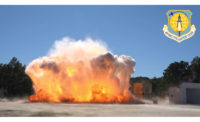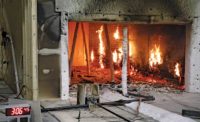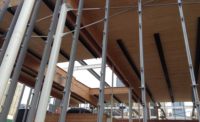Mass-timber-structure enthusiasts are calling results of recent flame-spread and fire-resistance tests on cross-laminated timber panels important yet not surprising. The CLT, made by the first certified supplier of the panels in the U.S., came through the tests with flying colors.
“This is an important first step that demonstrates that domestic CLT performs as well or better than the competition. The results will help set the stage for the development of a U.S.-based supply chain for mass-timber products,” says Thomas F. Robinson, founding principal of LEVER Architecture and the architect of the 12-story Framework, a mass timber building under design in building in Portland, Ore., that is on deck to be the tallest in the U.S.
Robinson and fire protection engineer David Barber, a principal with Arup—also working on Framework—have reviewed the test reports. Barber says the tests are significant not only because the results are good but because the Riddle, Ore.-based supplier, D.R. Johnson Wood Innovations, is both the first CLT supplier to carry out tests in the U.S. and the first to meet the two fire tests required under the International Building Code.
“D.R. Johnson is the only CLT supplier—U.S., Canadian or European—to have done this,” adds Barber.
CLT consists of layers of solid-sawn lumber, at right angles to each other and bonded with structural adhesives. The D.R. Johnson fire tests, which were done in late spring and early summer, apply only to D.R. Johnson’s CLT product.
The flame spread test was performed by QAI Laboratories, using the standard flame spread and smoke density classification tests in accordance with ASTM Designation E84-15b, Standard Method of Test for Surface Burning Characteristics of Building Materials.
The test identifies the rate of the spread of fire across the building material. D.R. Johnson’s CLT specimen achieved an A rating—the highest of three possible classifications—which indicates there was minimal fire spread across the material over the test’s standard time period. “That means D.R. Johnson’s panels can be used in all areas of a building as an interior finish,” says Barber.
The fire-resistance test was performed by a separate U.S.-based firm, which declines to be identified, using ASTM E119-16, “Standard Test Methods for Fire Tests of Building Construction and Materials.” The test evaluates the period a building material will contain a fire, or retain its structural integrity, during a predetermined fire-exposure time.
For the D.R. Johnson’s two-hour CLT fire-resistance test, the underside of the specimen was exposed—other CLT tests had encased it in drywall. The exposed specimen contained the fire and maintained structural integrity for the full time period, according to D.R. Johnson.
“These tests confirm what the design community already knew,” says Benton Johnson, an associate structural engineer with architect-engineer Skidmore, Owings & Merrill. “CLT panels are very fire resistant and can be designed to satisfy code requirements.”






Post a comment to this article
Report Abusive Comment